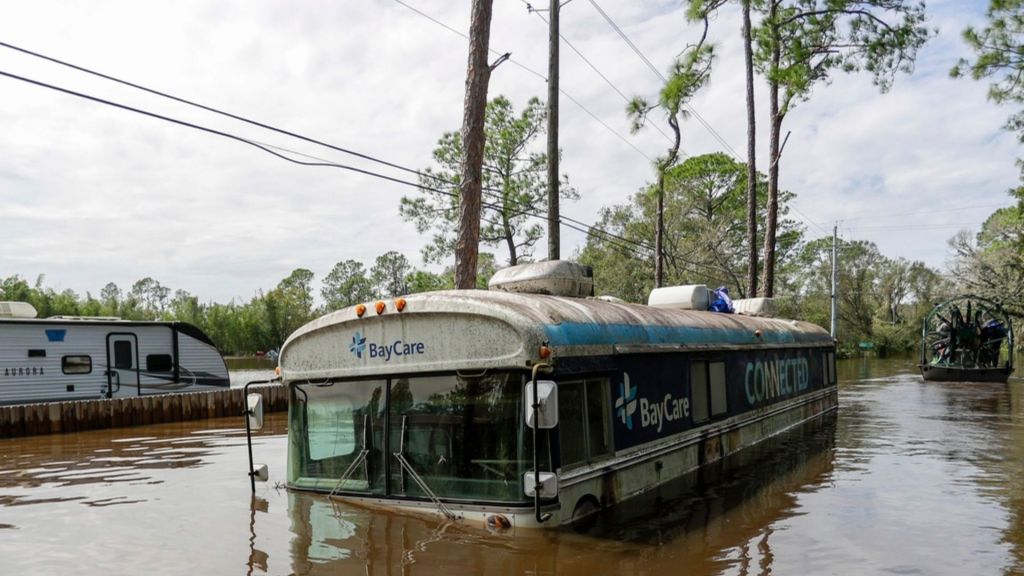By Chris O’Meara, Brendan Farrington and Ty O’Neil
The Associated Press
LITHIA, Fla. (AP) — Florida residents slogged through flooded streets, gathered up scattered debris and assessed damage to their homes on Oct. 11 after Hurricane Milton smashed through coastal communities and spawned a barrage of deadly tornadoes.

At least 10 people were dead, and rescuers were still saving people from swollen rivers, but many expressed relief that Milton wasn’t worse. The hurricane spared densely populated Tampa a direct hit, and the lethal storm surge that scientists feared never materialized.
Gov. Ron DeSantis warned people to not let down their guard, however, citing ongoing safety threats including downed power lines and standing water that could hide dangerous objects.
“We’re now in the period where you have fatalities that are preventable,” DeSantis said. “You have to make the proper decisions and know that there are hazards out there.”
About 2.2 million customers remained without power in the state, according to poweroutage.us. St. Petersburg’s 260,000 residents were told to boil water before drinking, cooking or brushing their teeth, until at least Oct. 14.
Also Oct. 11, the owner of a major phosphate mine disclosed that pollution spilled into Tampa Bay during the hurricane.
The Mosaic Company said in a statement that heavy rains from the storm overwhelmed a collection system at its Riverview site, pushing excess water out of a manhole and into discharges that lead to the bay. The company said the leak was fixed Oct. 10.
Mosaic said the spill likely exceeded a 17,500-gallon minimum reporting standard, though it did not provide a figure for what the total volume might have been.
Calls and emails to Mosaic seeking additional information about Riverview and the company’s other Florida mines received no response, as did a voicemail left with the Florida Department of Environmental Protection.
The state has 25 such stacks containing more than 1 billion tons of phosphogypsum, a solid waste byproduct of the phosphate fertilizer mining industry that contains radium, which decays to form radon gas. Both radium and radon are radioactive and can cause cancer. Phosphogypsum may also contain toxic heavy metals and other carcinogens, such as arsenic, cadmium, chromium, lead, mercury and nickel.
Florida’s vital tourism industry has started to return to normal, meanwhile, as Walt Disney World and other theme parks reopened. The state’s busiest airport, in Orlando, resumed full operations Oct. 11.
Arriving just two weeks after the devastating Hurricane Helene, Milton flooded barrier islands, tore the roof off the Tampa Bay Rays ‘ baseball stadium and toppled a construction crane.
Crews from the Hillsborough County Sheriff’s Office on Oct. 11 were assisting with rescues of people, including a 92-year-old woman, who were stranded in rising waters along the Alafia River. The river is 25 miles (40 kilometers) long and runs from eastern Hillsborough County, east of Tampa, into Tampa Bay.
In Pinellas County, deputies used high-water vehicles to shuttle people back and forth to their homes in a flooded Palm Harbor neighborhood where waters continued to rise.
Ashley Cabrera left with her 18- and 11-year-old sons and their three dogs, Eeyore, Poe and Molly. It was the first time since Milton struck that they had been able to leave the neighborhood, and they were now headed to a hotel in Orlando.
“I’m extremely thankful that we could get out now and go for the weekend somewhere we can get a hot meal and some gas,” Cabrera said. “I thought we’d be able to get out as soon as the storm was over. These roads have never flooded like this in all the years that I’ve lived here.”
Animals were being saved, too. Cindy Evers helped rescue a large pig stuck in high water at a strip mall in Lithia, east of Tampa. She had already rescued a donkey and several goats after the storm.
“I’m high and dry where I’m at, and I have a barn and 9 acres,” Evers said, adding that she will soon start to work to find the animals’ owners.
In the Gulf Coast city of Venice, Milton left behind several feet of sand in some beachfront condos, with one unit nearly filled. A swimming pool was packed full of sand, with only its handrails poking out.
Some warnings were heeded and lessons learned. When 8 feet (2.4 meters) of seawater flooded Punta Gorda during Hurricane Helene last month, 121 people had to be rescued, Mayor Lynne Matthews said. Milton brought at least 5 feet (1.5 meters) of flooding, but rescuers only had to save three people.
“So people listened to the evacuation order,” Matthews said.
Heaps of fruit were scattered across the ground and trees toppled over after both Milton and Hurricane Helene swept through Polk County and other orange-growing regions, Matt Joyner of trade group Florida Citrus Mutual said Oct. 11.
Milton arrived at the start of the orange growing season, so it is still too early to evaluate the full scope of the damage.
Florida has already seen orange production diminish over the years, with the industry still recovering from hurricanes of years past while also waging an ongoing battle against a deadly greening disease. Milton could be the knockout punch for some growers, Joyce said.
In the western coastal city of Clearwater, Kelvin Glenn said it took less than an hour early Oct. 10 for water to rise to his waist inside his apartment. He and seven children, ranging in age from 3 to 16, were trapped in the brown, foul floodwaters for about three hours before an upstairs neighbor opened their home to them.
Later that day, first responders arrived in boats to ferry them away from the building.
“Sitting in that cold, nasty water was kind of bad,” Glenn said.
Short-term survival is now turning into long-term worries. A hotel is $160 a night. Everything inside Glenn’s apartment is gone. And it can take time to get assistance.
“I ain’t going to say we’re homeless,” Glenn said. “But we’ve got to start all over again.”
The Federal Emergency Management Agency has enough money to deal with the immediate needs of people impacted by Helene and Milton but will need additional funding at some point, FEMA administrator Deanne Criswell said Oct. 11.
The disaster assistance fund helps pay for the swift response to hurricanes, floods, earthquakes and other disasters. Congress recently replenished the fund with $20 billion — the same amount as last year.
___
Farrington reported from St. Petersburg, Florida. Associated Press journalists Terry Spencer outside of Fort Lauderdale, Florida; Stephany Matat in Fort Pierce, Florida; Freida Frisaro in Fort Lauderdale; Lolita Baldor and Michael Biesecker in Washington; and Jeffrey Collins in Columbia, South Carolina, contributed.
The post Residents slog through flooded streets, clear debris after Hurricane Milton tore through Florida appeared first on AFRO American Newspapers.











